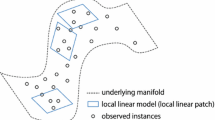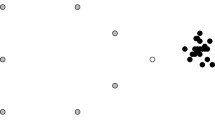Abstract
The problem of graph classification has attracted much attention in recent years. The existing work on graph classification has only dealt with precise and deterministic graph objects. However, the linkages between nodes in many real-world applications are inherently uncertain. In this paper, we focus on classification of graph objects with uncertainty. The method we propose can be divided into three steps: Firstly, we put forward a framework for classifying uncertain graph objects. Secondly, we extend the traditional algorithm used in the process of extracting frequent subgraphs to handle uncertain graph data. Thirdly, based on Extreme Learning Machine (ELM) with fast learning speed, a classifier is constructed. Extensive experiments on uncertain graph objects show that our method can produce better efficiency and effectiveness compared with other methods.





Similar content being viewed by others
References
Taylor JG. Cognitive computation. Cogn Comput. 2009;1(1):4–16.
Wollmer M, Eyben F, Graves A, Schuller B, Rigoll G. Bidirectional LSTM networks for context-sensitive keyword detection in a cognitive virtual agent framework. Cogn Comput. 2010;2(3):180–90.
Mital P, Smith T, Hill R, Henderson J. Clustering of gaze during dynamic scene viewing is predicted by motion. Cogn Comput. 2011;3(1):5–24.
Cambria E, Hussain A. “Sentic computing: techniques, tools, and applications”, SpringerBriefs in cognitive computation. Dordrecht: Springer; 2012.
Wang Q, Cambria E, Liu C, Hussain A. Common sense knowledge for handwritten Chinese recognition. Cogn Comput. 2013;5(2):234–42.
Xu Y, Guo R, Wang L. A twin multi-class classification support vector machine. Cogn Comput. 2013;5(4):580–8.
Tsivtsivadze E, Urban J, Geuvers H, Heskes T. Semantic graph kernels for automated reasoning. In: SDM, 2011. pp. 795–803.
Tamas H, Thomas G, Stefan W. Cyclic pattern kernels for predictive graph mining. In: KDD, 2004. pp. 158–167.
Thomas G, Peter F, Stefan W. On graph kernels: hardness results and efficient alternatives. In: COLT, 2003. pp. 129–143.
Jin N, Young C, Wang W. GAIA: graph classification using evolutionary computation. In: SIGMOD, 2010. pp. 879–890.
Thoma M, Cheng H, Gretton A, Han J, Kriegel H-P, Smola AJ, Song L, Yu PS, Yan X, K.M. Borgwardt: near-optimal supervised feature selection among frequent subgraphs. In: SDM, 2009. pp. 1075–1086.
Jin N, Young C, Wang W. Graph classification based on pattern co-occurrence. In: CIKM, 2009. pp. 573–582.
Kong X, Yu PS. Semi-supervised feature selection for graph classification. In: SIGKDD, 2010. pp. 793–802.
Bifet A, Holmes G, Pfahringer B, Gavald R. Mining frequent closed graphs on evolving data streams. In: SIGKDD, 2011. pp. 591–599.
Yan X, Han J. gSpan: graph-based substructure pattern mining. ICDM, 2002. pp. 721–724.
Parthasarathy S, Tatikonda S, Duygu U. A survey of graph mining techniques for biological datasets. In: Managing and mining graph data, 2010. pp. 547–580.
Jiang C, Coenen F, Zito M. A survey of frequent subgraph mining algorithms. In: Knowledge Engineering Review, 2013. pp. 75–105.
Thoma M, Cheng H, Gretton A, Han J, Kriegel HP, Smola A, Orgwardt KM. Discriminative frequent subgraph mining with optimality guarantees. Stat Anal Data Min. 2010;3(5):302–18.
Shelokar P, Quirin A, Cordn O. MOSubdue: a Pareto dominance-based multiobjective subdue algorithm for frequent subgraph mining. Knowl Inf Syst. 2013;34(1):75–108.
Huang G-B, Zhu QY, Siew CK. Extreme learning machine: theory and applications. Neurocomputing. 2006;70(1):489–501.
Zhao Z, Chen Z, Chen Y, Wang S, Wang H. A class incremental extreme learning machine for activity recognition. Cogn Comput. 2014. doi:10.1007/s12559-014-9259-y.
Wang X, Shao Q, Miao Q, Zhai J. Architecture selection for networks trained with extreme learning machine using localized generalization error model. Neurocomputing. 2013;102:3–9.
Huang G-B, Zhou H, Ding X, Zhang R. Extreme learning machine for regression and multiclass classification. IEEE Trans Syst. 2012;42(2):513–29.
Miche Y, Sorjamaa A, Bas P, Simula Q, Jutten C, Lendasse A. OP-ELM: optimally pruned extreme learning machine. Neural Netw. 2010;21(1):158–62.
Mishra A, Goel A, Singh R, Chetty G, Singh L. A novel image watermarking scheme using extreme learning machine. In: Neural Networks (IJCNN), 2012. pp. 1–6.
Huang G-B, Wang DH, Lan Y. Extreme learning machines: a survey. Int J Mach Learn Cybern. 2011;2(2):107–22.
Zong W, Huang G-B. Learning to rank with extreme learning machine. Neural Process Lett. 2013;39(2):1–12.
Zong W, Huang G-B, Chen Y. Weighted extreme learning machine for imbalance learning. Neurocomputing. 2013;101:229–42.
Fletcher R. Practical methods of optimization. John Wiley & Sons, 2013. p. 2.
Cormen TH, Leiserson CE, Rivest RL, Stein C. Introduction to algorithms. In: Constrained optimization, 2001.
The protein structure. Retrieved May 6, 2013 from http://www.rcsb.org/pdb/.
Structural classification of proteins. Retrieved May 10, 2013 from http://scop.mrc-lmb.cam.ac.uk/scop/.
The database of compound structures. Retrieved May 8, 2013 from http://pubchem.ncbi.nlm.nih.gov.
Acknowledgments
This research was partially supported by the National Natural Science Foundation of China under Grant Nos. 61173029 and 61272182; New Century Excellent Talents in University (NCET-11-0085).
Author information
Authors and Affiliations
Corresponding author
Rights and permissions
About this article
Cite this article
Han, D., Hu, Y., Ai, S. et al. Uncertain Graph Classification Based on Extreme Learning Machine. Cogn Comput 7, 346–358 (2015). https://doi.org/10.1007/s12559-014-9295-7
Received:
Accepted:
Published:
Issue Date:
DOI: https://doi.org/10.1007/s12559-014-9295-7




